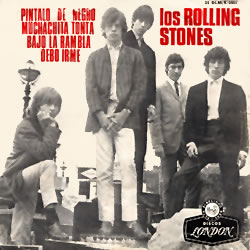

With flowers and my love, both never to come back I see a line of cars and they’re all painted black I have to turn my head until my darkness goes I see the girls walk by dressed in their summer clothes No colors anymore I want them to turn black I see a red door and I want it painted black

The song became popular throughout Europe and around the world. It remained in the Top 40 for ten weeks through the summer. in late May, holding the top position for two weeks or so.

Released as a single, the record reached No. “Paint It Black,” written by Mick Jagger and Keith Richards, is not a happy tune in its lyrics, but in 1966 its musical appeal pushed it to the top of the pop charts. It was one of those hard-driving rock ‘n roll tunes from this raucous new group that was catching on in a big way. About that time as well, around mid-May 1966, a new song titled “Paint It Black” by the British rock group the Rolling Stones, began to be heard across the U.S. In music, the Beach Boys had released their Pet Sounds album, and Bob Dylan his Blonde on Blonde album. Young Rolling Stones shown on German single, 1966. Louis Cardinals, had opened there earlier that spring. In the world of boxing, late May, Muhammad Ali, then known as Cassius Clay, would knock out the U.K.’s Henry Cooper in a six-round heavyweight match in London. Louis on May 25th, 1966. Busch Stadium, home to baseball’s St. Secretary of the Interior Stewart Udall dedicated the new Gateway Arch in St. In America, Vice-President Hubert Humphrey and U.S. In Vietnam, meanwhile, the military government of South Vietnam under Premier Ky was doing battle with Buddhist rebels in Da Nang in mid-May. China at this time had made its Cultural Revolution pronouncement.ĭespite these woes, the day-to-day rhythms of life went on as normal throughout much of the world. involvement in Vietnam, had given his famous “Arrogance of Power” speech at Johns Hopkins University, critical of the “might-makes-right” approach and more, aimed squarely at the U.S. William Fulbright (D-AR), one of the few Senators challenging U.S. troop strength had reached 200,000 by then, and draft quotas at home had doubled.Įarlier that spring, in April, U.S. In the spring of 1966, all was not well in the world. The Vietnam War was then raging and American involvement there was escalating. U.S. Click for Rolling Stones “Hot Rocks” album. The Rolling Stones and the Beatles, however, were completely subverting this: They’d both been at it for three years and showed absolutely no signs of slowing down, even if John Lennon’s “more popular than Jesus” line caused a bump in the road for the latter act.Record sleeve for ‘Paint It Black’ single issued in South Africa, 1966. The group was on a grueling British tour in October of 1966, often playing two shows a night, but during a four-day break they headed to Studio 5 at Wembley and taped a three-song set for Ready Steady Go!, sharing the stage with Eric Burdon and the Animals and Paul & Barry Ryan, an almost totally forgotten pair of twin brothers whose career lasted just about a year.Ī career path like Paul & Barry Ryan was the norm for a pop act at this time: a handful of hits before fading into complete oblivion. The Rolling Stones 1963-1969: Behind-the-Scenes Snapshots “Mother’s Little Helper,” “Lady Jane” and “Have You Seen Your Mother, Baby, Standing In The Shadow” also got a lot of airplay. Their fourth album, Aftermath, hit stores that April, and their sitar-infused single “Paint It Black” spent two weeks at Number One on the Billboard Hot 100 in June. The Rolling Stones were nearing their peak as pop hit makers when they appeared on Ready Steady Go! on October 7th, 1966.


 0 kommentar(er)
0 kommentar(er)
